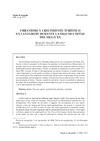Identificador persistente para citar o vincular este elemento:
https://accedacris.ulpgc.es/jspui/handle/10553/59002
| Campo DC | Valor | idioma |
|---|---|---|
| dc.contributor.author | González Morales, Alejandro | en_US |
| dc.date.accessioned | 2019-12-17T15:21:49Z | - |
| dc.date.available | 2019-12-17T15:21:49Z | - |
| dc.date.issued | 2006 | en_US |
| dc.identifier.issn | 1989-4627 | en_US |
| dc.identifier.other | Dialnet | |
| dc.identifier.uri | https://accedacris.ulpgc.es/handle/10553/59002 | - |
| dc.description.abstract | En este trabajo analizamos las diferentes etapas por las que ha pasado el desarrollo turístico de la isla de Lanzarote. Se distinguen tres periodos de características diferenciadas. El primero, antes de los años setenta, supone el desarrollo de una incipiente industria turística, donde predominan el capital belga y francés; el segundo es un periodo que abarca desde 1973 hasta 1983, en estos 10 años la isla experimenta un cambio sustancial, el capital alemán se vuelve hegemónico y se desarrolla con fuerza el denominado turismo de masas, sobre todo en el municipio de Tías (Puerto del Carmen); por último a partir de principios de los ochenta nos encontramos con una etapa de similares características que la anterior hasta 1995, con un gran desarrollo de Yaiza y Teguise, a partir de esta fecha y hasta la actualidad se introducen los valores de sostenibilidad, aunque sin demasiado éxito, pues se sigue construyendo mucho y no de precisamente alta calidad. | en_US |
| dc.description.abstract | In that work we analyzed the different stages through which it has passed the development tourist of the island of Lanzarote. Three periods of differentiated characteristics are distinguished. First, before the Seventies, it supposes the development of a new tourist industry, where the belgian and french capital predominates; the second is a period that includes from 1973 to 1983, in these 10 years the island experiences a substantial change, the german capital becomes hegemonic and the denominated tourism of masses is developed with force, mainly in the municipality of Tías (Pto. of the Carmen); fi nally from principles of the eighty we were with a stage of characteristic similars that the previous one until 1995, with a great development of Yaiza and Teguise, as of this date and until the present time introduce the values of sustainability, although without too much success, because it is continued constructing much and of indeed high calidadscribe or does not stick the text here to translate. | en_US |
| dc.language | spa | en_US |
| dc.relation.ispartof | Papeles de geografía | en_US |
| dc.source | Papeles de geografía [ISSN 1989-4627] (44), p. 39-58 | en_US |
| dc.subject | 531290 Economía sectorial: turismo | en_US |
| dc.subject | 5506 Historia por especialidades | en_US |
| dc.subject.other | Turismo | en_US |
| dc.subject.other | Capital | en_US |
| dc.subject.other | Sostenibilidad | en_US |
| dc.subject.other | Periodos | en_US |
| dc.subject.other | Lanzarote | en_US |
| dc.subject.other | Tourism | en_US |
| dc.subject.other | Sustainability | en_US |
| dc.subject.other | Periods | en_US |
| dc.title | Urbanismo y crecimiento turístico en Lanzarote durante la segunda mitad del siglo XX | en_US |
| dc.type | info:eu-repo/semantics/article | en_US |
| dc.type | Article | en_US |
| dc.identifier.url | http://dialnet.unirioja.es/servlet/articulo?codigo=2303575 | - |
| dc.description.lastpage | 58 | - |
| dc.identifier.issue | 44 | - |
| dc.description.firstpage | 39 | - |
| dc.investigacion | Ciencias Sociales y Jurídicas | en_US |
| dc.type2 | Artículo | en_US |
| dc.contributor.authordialnetid | 896321 | - |
| dc.identifier.dialnet | 2303575ARTREV | - |
| dc.identifier.ulpgc | Sí | es |
| dc.description.erihplus | ERIH PLUS | |
| item.grantfulltext | open | - |
| item.fulltext | Con texto completo | - |
| crisitem.author.dept | GIR IATEXT: Sociedades y Espacios Atlánticos | - |
| crisitem.author.dept | IU de Análisis y Aplicaciones Textuales | - |
| crisitem.author.orcid | 0000-0001-9467-8442 | - |
| crisitem.author.parentorg | IU de Análisis y Aplicaciones Textuales | - |
| crisitem.author.fullName | González Morales,Alejandro | - |
| Colección: | Artículos | |
Visitas
37
actualizado el 28-oct-2023
Descargas
26
actualizado el 28-oct-2023
Google ScholarTM
Verifica
Comparte
Exporta metadatos
Los elementos en ULPGC accedaCRIS están protegidos por derechos de autor con todos los derechos reservados, a menos que se indique lo contrario.
